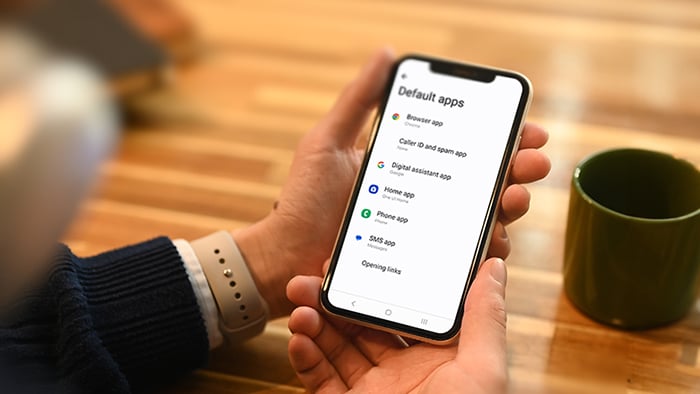It’s important to note that Microsoft no longer issues security updates for Internet Explorer. Nevertheless, many people still use IE — while it has less than 1% of the global browser market share, that’s still millions of people. If you’re still using Internet Explorer, you should change your default browser to protect your device against malware that can exploit the potential security weaknesses of IE.
How to stop pop-ups on Internet Explorer
The latest version of Internet Explorer, IE 11, comes with capabilities to enable and disable Internet Explorer pop-up blockers. This process will only block pop-ups, and not all ads. If you want to block all ads in your browser, installing an ad blocker extension will do the job.
Here’s how to block pop-ups in Internet Explorer:
-
Open Internet Explorer and select Tools (the gear icon in the upper-right corner of the browser).
/img_01.png?width=300&name=img_01.png)
-
Select Internet Options from the menu.
/img_02.png?width=450&name=img_02.png)
-
Select the tab Privacy when the dialog box opens.
/img_03.png?width=450&name=img_03.png)
-
Check the box to block pop-ups in the section called Pop-up Blocker. (This may already be checked, as IE blocks pop-ups by default.)
/img_04.png?width=450&name=img_04.png)
-
Select Apply to save the changes. The Internet Explorer pop-up blocker is now enabled.
/img_05.png?width=450&name=img_05.png)
If you’re already poking around the Tools section, you can also try deleting your cookies and clearing your browser history so that your browsing is faster and smoother overall. As mentioned above, since Internet Explorer is no longer being updated, you should switch to another browser with strong privacy and security features.
How to stop Microsoft Edge pop-ups
Depending on the version of Edge you have, pop-ups may already be blocked by default. Here’s how to find the pop-up blocker so you can stop pop-ups in Microsoft Edge.
-
Open a new browser window and go to the user menu (click the three horizontal dots on the right side).
/img_06.png?width=350&name=img_06.png)
-
Select Settings (near the bottom of the menu). The Settings menu should open in a new tab.
/img_07.png?width=400&name=img_07.png)
-
Select Cookies and site permissions in the Settings menu.
/img_08.png?width=400&name=img_08.png)
-
Go to Pop-ups and redirects.
/img_09.png?width=2165&name=img_09.png)
-
Toggle the Block setting to on if it isn’t already. This should stop all Microsoft Edge pop-ups.
/img_10.png?width=1617&name=img_10.png)
Blocking pop-ups on Edge and IE takes just a few clicks. If you’ve blocked pop-ups and still see them, your computer may have some type of malware or an unwanted browser extension installed. In that case, you should uninstall any unrecognized browser extensions and use strong antivirus software to find the problem.
While blocking pop-ups on Edge and IE is pretty easy, there are other web browsers that make blocking pop-ups even easier — while offering strong security protections. Avast Secure Browser is a dedicated privacy browser that, along with blocking pop-ups, also automatically blocks all ads and other intrusive content that slows down your browsing.
Avast Secure Browser also has advanced built-in security features such as malicious site blocking and forced HTTPS encryption, making your browsing much more secure. With all these features and more, it’s time you switched to a modern browser.
Looking to block pop-ups in Chrome?
You can block pop-ups in every browser, including Chrome. You’ll find the option to block or unblock pop-ups in the settings. To learn more, check out our guides for blocking pop-ups in Chrome, managing pop-ups in Firefox, and allowing or blocking pop-ups in Safari.
Should I block pop-ups?
You should block pop-ups if you want to see fewer ads or notifications while using your PC. But some sites use pop-ups to open a new window or for online forms, and if all pop-ups are blocked, some sites might not work properly.
To make sure all the sites you visit work as they should, learn how to allow certain pop-ups while keeping others blocked. Read on to learn how to enable pop-ups in Internet Explorer and Microsoft Edge.
How to allow pop-ups on Internet Explorer (IE)
If you want to experience all the features of certain websites, here’s how to allow pop-ups on Internet Explorer:
-
Open Internet Explorer and select Internet Options from the Tools menu.
/img_11.png?width=350&name=img_11.png)
-
In the Internet Options dialog box that opens, go to the Privacy tab.
/img_12.png?width=450&name=img_12.png)
-
Uncheck the Turn on Pop-up Blocker box to enable all pop-ups in IE. To allow pop-ups only on certain websites, skip this step and continue with the steps below.
/img_13.png?width=508&name=img_13.png)
-
Select the Settings button in the Pop-up Blocker section. A new dialog box called Pop-Up Blocker Settings should appear.
/img_14.png?width=450&name=img_14.png)
-
Go to the “Address of website to allow” field and type in the address of the website you want to allow pop-ups on. Repeat as necessary for each website whose pop-ups you want to allow.
/img_15.png?width=450&name=img_15.png)
How to allow pop-ups on Microsoft Edge
For Microsoft Edge, the process of allowing pop-ups is very similar to blocking pop-ups. Here’s how to allow pop-ups on Edge:
-
Open your Edge browser, go to the user menu (the three horizontal dots in the upper right), and select Settings.
/img_16.png?width=400&name=img_16.png)
-
Select Cookies and site permissions in the Settings menu.
/img_17.png?width=400&name=img_17.png)
-
Scroll down and click Pop-ups and redirects.
/img_18.png?width=2165&name=img_18.png)
-
Toggle Block to off.
/img_19.png?width=1662&name=img_19.png)
-
Click the Add button in the Allow box to allow pop-ups on specific sites.
/img_20.png?width=1617&name=img_20.png)
-
Type or paste the website address in the Add a site box. Repeat this for each site you want to allow pop-ups on.
/img_21.png?width=1594&name=img_21.png)
And it’s as simple as that. Now you can allow and block pop-ups however you want. In the Edge browser menu you can also adjust other settings, such as enabling and disabling cookies. To keep your browser in top shape, be sure to use a browser cleaning tool to get rid of clutter and other junk that builds up over time.
Should I allow pop-ups?
Allowing pop-ups for certain sites can make your browsing experience easier. While many pop-ups are annoying ads or even links to unsafe websites, they can sometimes be useful. Some sites may display their terms of service or other important information in a pop-up.
Pop-ups may also be used to show download notifications or dialog boxes. And sometimes, videos can appear as pop-ups. The best approach for most browsers is to keep pop-ups blocked by default, and to add sites to your allow pop-ups list when necessary.
Browse uninterrupted with Avast Secure Browser
You can fool around with the settings in Edge or IE, or you can block pop-ups immediately with the free Avast Secure Browser. Our advanced browser automatically blocks all pop-ups, or you can choose from three tiers of blocking preferences: Light, Basic, and Strict, which you can easily adjust to suit your needs.
/img_22.png?width=1000&name=img_22.png) Avast Secure Browser blocks pop-ups automatically for a better browsing experience.
Avast Secure Browser blocks pop-ups automatically for a better browsing experience.
And Avast Secure Browser offers even more by default: ad blocking, automatic HTTPS encryption, and an assortment of other features that block malicious websites, phishing attacks, and third-party attempts to get your personal data. For a smoother, safer browsing experience without having to bother with changing the settings, switch to Avast Secure Browser today.
/Academy-How-to-allow-and-block-pop-ups-in-Edge-or-IE-Hero.jpg?width=1200&name=Academy-How-to-allow-and-block-pop-ups-in-Edge-or-IE-Hero.jpg)
/img_01.png?width=300&name=img_01.png)
/img_02.png?width=450&name=img_02.png)
/img_03.png?width=450&name=img_03.png)
/img_04.png?width=450&name=img_04.png)
/img_05.png?width=450&name=img_05.png)
/img_06.png?width=350&name=img_06.png)
/img_07.png?width=400&name=img_07.png)
/img_08.png?width=400&name=img_08.png)
/img_09.png?width=2165&name=img_09.png)
/img_10.png?width=1617&name=img_10.png)
/img_11.png?width=350&name=img_11.png)
/img_12.png?width=450&name=img_12.png)
/img_13.png?width=508&name=img_13.png)
/img_14.png?width=450&name=img_14.png)
/img_15.png?width=450&name=img_15.png)
/img_16.png?width=400&name=img_16.png)
/img_17.png?width=400&name=img_17.png)
/img_18.png?width=2165&name=img_18.png)
/img_19.png?width=1662&name=img_19.png)
/img_20.png?width=1617&name=img_20.png)
/img_21.png?width=1594&name=img_21.png)
/img_22.png?width=1000&name=img_22.png) Avast Secure Browser blocks pop-ups automatically for a better browsing experience.
Avast Secure Browser blocks pop-ups automatically for a better browsing experience.










